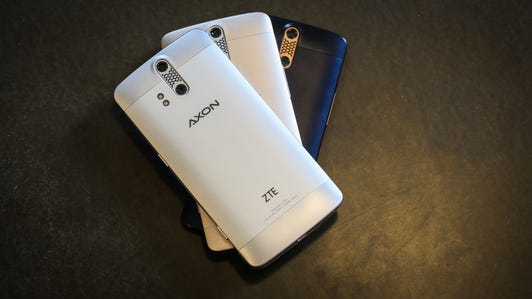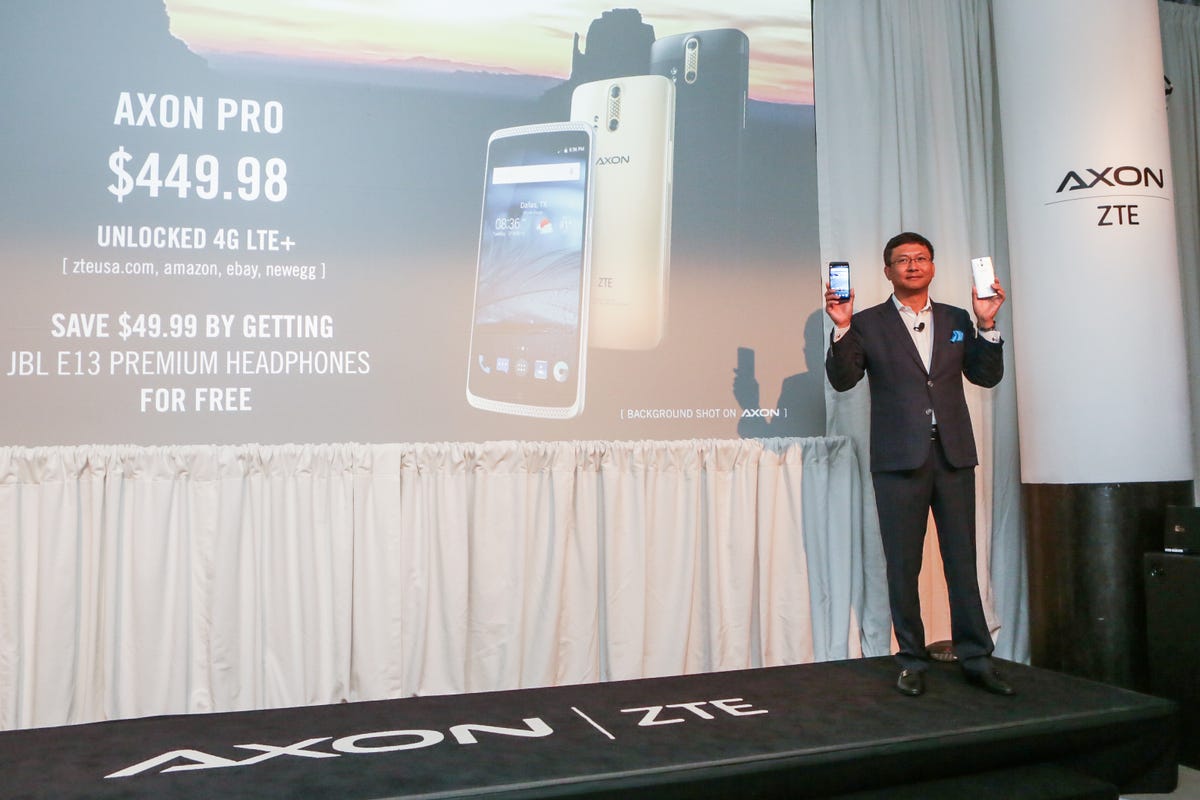
ZTE
ZTE wants to make the leap into the premium smartphone league in the US.
The Chinese telecommunications vendor, the fourth-largest smartphone vendor in the US, on Tuesday introduced the first product in its new Axon flagship series. But unlike the Samsung or HTC route of partnering with all of the US carriers to sell the device, ZTE will sell the phone on its own website.
The Axon Pro will sell for $449.98 unlocked and initially only work with AT&T and T-Mobile. The phone will start shipping on July 27.
ZTE’s decision to take its new flagship brand directly to consumers is part of a broader push by lesser-known smartphone manufacturers to bypass the usual distribution route of the carriers in an attempt to build their own brand awareness. These companies have struggled to sell their slickest products at carrier stores, where sales of Apple’s iPhone and Samsung’s Galaxy S smartphones have dominated.
Instead, companies such as ZTE, as well as Huawei and Alcatel, are pushing their own websites, or ones affiliated with online retailers such as Amazon, as the destination for affordable but high-quality smartphones. ZTE already said another sub-brand, its Nubia Z9, would go on sale in the US through its own website later this year.
It’s been a boon for bargain hunters who know where to look for a deal, although a vast majority of people still prefer to buy their smartphones from a wireless carrier.
“This is a small segment of the market right now,” said Avi Greengart, an analyst at Current Analysis. “Consumers are going to need an overwhelming push to change.”
ZTE has been keen on making a bigger splash here. It took a curious route with the invitations to the launch event for Axon. The company sent out notifications of the Tuesday event packed with a Cardboard-esque virtual reality viewer. ZTE’s name wasn’t mentioned on the invitation, which listed a website for Axon, leading some to speculate that it was a potentially new venture.
ZTE’s elegant Axon Pro sports good looks and powerful specs (pictures)






+6 more
A day later, PC Mag discovered that Axon was a ZTE marketing stunt. A search of the Axon name uncovered that ZTE’s US unit owned the trademark. Also, there’s no connection with the virtual reality viewer — it was just a souvenir.
So why the mysterious introduction? “We wanted it to be about the phone,” said Jeff Yee, vice president of tech planning and partnerships with ZTE. “We wanted true honest feedback without brands or corporate influence.”
“Made for US consumers”
Lixin Cheng, president of ZTE’s US business, said the Axon Pro is the first unlocked smartphone designed in the US for US smartphone customers. He wouldn’t comment on whether it would be a global brand.
ZTE already has a flagship brand in the Nubia line of smartphones, but Cheng (no relation to this reporter) said that Nubia would act more as an independent line with its own direction, while Axon would serve as its core flagship brand.


Josh Miller/CNET
For many customers, the names ZTE, Nubia and Axon are likely meaningless. The company is hoping to turn some heads with the Axon Pro’s high-end components. The phones comes with high-end features such as high-fidelity, or Hi-Fi sound, which ZTE boasts is a first in the industry. Packaged with the phone are high-end JBL E13 in-ear headphones.
It also packs in two rear cameras — one that can capture 4K video and another for additional photography tricks. The company said the camera can focus in milliseconds and boasts a shutter speed of 1/90000 of a second, which allows you freeze frame a moving object with clarity.
The Axon Pro runs on a Qualcomm Snapdragon 810 process, has 4 gigabytes of RAM, 32GB of storage and a 3,000 mAh battery with quick-charge capabilities. It runs on Android 5.1, also known as Lollipop.
As with other premium smartphones, the Axon Pro was constructed with metal and glass, and comes in blue, gold and silver.
ZTE also introduced a program called Axon Passport 1.0, which includes a two-year warranty that involves free shipping and a 30-day “buyer’s remorse” return.
A standard playbook
ZTE is hoping to copy the success of Samsung’s Galaxy S franchise, which exploded onto the scene with a strategy of pushing high-end smartphones utilizing a single brand and model across all of the major carriers. Others, including HTC’s One and LG’s G families of smartphones, have attempted to follow suit with mixed results.


Sarah Tew/CNET
The difference between those vendors and ZTE is the lack of carrier support. ZTE is largely attempting to appeal directly to consumers — a strategy that hasn’t resulted in huge sales in the past. The key to Samsung’s early success was its willingness to pour massive amounts of resources into its marketing campaign. It helped that Samsung’s name was already prominent on televisions, computers and appliances.
ZTE has no such advantage. While the company is one of the world’s largest suppliers of telecommunications equipment, it has virtually no consumer brand awareness. The company has largely toiled in anonymity, selling low-cost smartphones in the prepaid marke or occupying the budget category of the larger carriers.
Consumers have expressed interest in Axon, Cheng said, noting that hundreds of thousands of people have visited the website, while tens of thousands of registered to get more information.
The company has been slowly making moves to get its name out. In October, ZTE became the official sponsor of the Madison Square Garden arena, where its brand is displayed prominently at New York Knicks basketball games. It was already the official smartphone of the Houston Rockets and the National Basketball Association champions, the Golden State Warriors.
ZTE would continue to connect with consumers in these targeted ways. But the company won’t be blanketing the airwaves with commercials like Apple or Samsung.
“We’ve got to do something different,” Cheng said.



